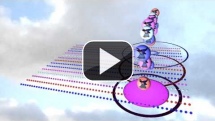- Video Resources
- How Steady is Your Tempo?
- Simple Time (2/4, 3/4, 4/4)
- Compound Time (6/8, 9/8, 12/8)
- Odd Time (5/4, 7/4 etc)
- Swung Notes
- Polyrhythms & Challenges
- Polymeters & Rhythm Phasing
- Harmonic Polyrhythms
- Additive Rhythms (Mixed Meters)
- Drum Rudiments
- Videos for Wikipedia
- Bounce on Lyrics
- Sprites & Special Characters
- Downloadable Audio Clips
- Fractal Tunes
- Check out the amazing rhythms Bounce can play
- Walkthrough of astonishingly versatile Bounce Metronome Pro
- Add to your site
- Free online visual metronome
- Recorder Tunes from the Heart
Sprites & Special Characters - with Unicode Support
The bounce motion helps with relaxation and precision. The bright colours and sprites and other bounce options can help with the enjoyment and fun aspect. When it is fun, you are relaxed and alert as well.
Fun, Relaxed and Alert
The bright colours of Bounce and the optional sprites are all to do with the fun side of it. When it is fun, you are relaxed and alert as well.
Tension and tedium in your metronome practice sessions can creep into your instrument technique. So making the metronome exercises relaxing and fun can work the other way and bring relaxation and enjoyment into your playing.
The bounce motion is a naturally relaxed motion to do - if your hand follows the motion of the bounce, depending on the tempo, it may even be in free-fall during the bounce. So, a good way to relate to the relaxation aspect of the bounce visuals is to start with percussion, no matter what your actual instrument is, and follow the visual bounce with your hand or drum stick.
This motion is also naturally precise as well. That's why conductors use a bounce action when conducting. They bounce the baton "off the invisible horizontal plane" as a way to show the beat precisely and clearly.
This relaxation, precision, and enjoyment in the bounce motion can help encourage those qualities into your own playing.
METRONOME TECHNIQUE - PRACTISE TIP
This tip may help with elaxation, precision, and enjoyment in metronome technique. The way most musicians use a metronome is that they simply play their music along with it. It's much more relaxing, however, and easier, and you may make faster progress, if you practise with the metronome in separate exercises.
That's because natural human rhythms are highly variable, with subtle tempo variation in every measure, even if just of a few BPM, when you play in a relaxed and lively way. So - when you play your music along with a steady metronome click, there is something a bit unnatural and possibly "forced" about that too, for most styles of music at least.
The idea is that you work with a metronome to strengthen your sense of rhythm and your inner pulse - take something you have already and make it stronger, and steadier. Also at the same time the metronome exercises help refine your sense of time and precision of playing in time.
The Mac Santiago and Andrew Lews books on rhythm and metronome go into this in detail with many exercises and suggestions for ways to practise. If it is new to you, you might also like the section about it which I wrote for the wikipedia article on the metronome:
See Metronome Technique in the wikipedia article on the metronome, and The Many ways to use a metronome section of the Bounce Metronome Wiki
http://en.wikipedia.org/wiki/Metronome#Metronome_Technique
Playlist of all of them
Use these videos as a resource
You can use any of these videos as a resource for your own website or wikis, or as part of a youtube mix, or make more of them yourself - see Add videos like these to your own site
Play these rhythms and animations at any tempo with Bounce Metronome
You can use Bounce Metronome Pro to practise these and many more rhythms at any tempo, including changing tempo.
What you can do with this feature
You can use any image for the sprite (you may need to change the background colour first), and Bounce comes with a collection of examples to get you started, and an installer with extra sprites, including the ones in these videos.












